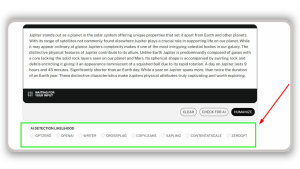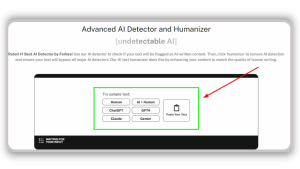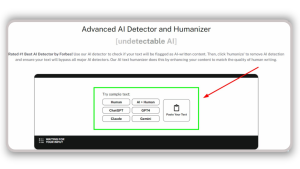
Introduction
Oftentimes, whenever we are to travel the ever-changing fields of artificial intelligence (AI), I become even more interested in dual nature that exists within this technology. On one hand, we have prefabricated networks that diligence to evolve the differentiation of the true and false algorithms of the world. On the other hand, systems go radio-silent sneaking out AI-penned content under the nose of detection mechanisms designed to alarm a warning to such systems. In this blog post, I will delve into the importance of both AI detection and undetectable AI tools, exploring its implications, benefits, and potential risks.

The Significance of AI Detection
Having AI detection has become an absolute necessity in our digital world. Managing time learning about and using AI technologies, I can confirm, that, being able to single out AI-generated content is slowly yet steadily becoming a pivotal skill throughout the digital world. We have this assurance as the detection of AI-powered content is a mainstay of the technology that guarantees the integrity of the data. With such shortcomings, AI detection devices fill in the missing gaps of information by revealing the source of the content. It is especially essential in fields that require the honesty of the author to be preserved like journalism, academia, and creative industries where self-expression and human innovation are the main values.

1. Preserving Authenticity and Trust
In a period of time when the abundance of information ranges, the art of distinguishing between human-authored and the AI-manufactured content is of highest worth. By means of AI detection tools, the credibility of data is secured through providing the opportunity to find where content comes from. It is especially crucual in areas such as news reporting, academic papers, and the film, television sector where human creativity and storytelling are highly appreciated among others.
2. Protecting Intellectual Property
Along with the advancement of AI in generating content, comes the greater danger of the infringement of intellectual property. AI detection tools can identify plagiarism and unauthorized use of AI generated content, hence, protect the rights of the real authors and ensure the presence of fair competition in the markets offering different goods and services.

3. Ensuring Academic Integrity
The activation of AI detection is indeed an integral part of academic institutions in the struggle for the improvement of academic honesty. As AI writing assistants have appeared, the task has become a must for the educators to be capable of the distinguishing of the work which is written by a student from the one which is generated by AI. This will help in maintaining accurate results of the educational evaluations and will ensure that learners are developing their own skills and knowledge.
4. Enhancing Cybersecurity
The AI detection tools are not only limited to identification of AI-generated text they are also playing a significant role in cybersecurity, detecting such AI-driven cyber threats as deepfakes, phishing attempts, and other more sophisticated attacks. By revealing the AI-generated threats, we are able to arm the individuals and firms against potential contenders.
5. Fostering Ethical AI Development
The presence of AI detection tools allows software engineers to create transparent and ethical AI systems. Understanding that their AI output can be identified, developers receive a nudge to disclose more information about the use of AI as well as to make sure that for the most part their systems are handled responsibly.
The Rise of Undetectable AI Tools
While AI detection tools are the pillars that hold the structure of the detection of such technologies, undetectable AI tools silently occupy this space as the dark side and the light side of the matter. Products do this by being less conspicuous than traditional AI technologies which permit them to be overly confident towards AI detection systems and at the same time provoke the consumers’ curiosity and even fear. However, the creation of undetectable AI tools has an impact on the detection side and on the other hand, some benefits from it as well:
1. Pushing the Boundaries of AI Technology
Undetectable AI tools development appears to be the strong demand for AI technology that is technologically challenging. It shatters the ideas of what AI can really do making great inroads in the field of natural language processing, machine learning, and other cognate fields. The continuous flux of information serves as the main driver of the AI development in different areas of human activity.
2. Enhancing Privacy and Security
Undetectable AI tools may serve as instruments of privacy and security in certain areas. For instance, they could be used to generate cloaked information that protects the confidentiality of people who are in trouble or are involved in whistleblowing. However, it should be emphasized that the flip side of this coin, which involves ethical considerations, is indispensable as well.

3. Leveling the Playing Field
Uniformity of AI is essential for AI to be easily accessible to all people, regardless of the size of the organization. As a result, opportunities are end to end the spectrum for innovators to exhibit their talents and skills. Thus, the spread of these AI tools has enormous potential for creativity and diversity in various branches of education.
4. Testing and Improving AI Detection Systems
One striking feature of undetectable AI tools is that they are the drivers of continuous improvement in detection technologies. This never-ending pursuit between evasion methods and detection technologies ultimately results in the development of more accurate and resilient AI detection solutions.
5. Exploring Ethical and Legal Boundaries
The product and use of undetectable AI tools elicit the overarching ethical and legal concerns. Thus, the use of this technology paves the way for necessary discourse not only in technology areas but also in the responsible applications of AI, privacy rights, and possible new regulations in AI use.
The Ethical Implications
When we talk about AI detection and undetectable AI tools, ethics must not be omitted from the equation.:

Transparency and Accountability
Undetectable AI tools are under scrutiny due to tendencies to disappear a line between honesty and anonymity of the creators. As the AI-generated material merges and becomes indistinguishable from the works of human authors, it becomes a challenge for the readers to trust the reports and researches. This issue is even more acute, for instance, in such sectors as journalism, scientific research, and arts.
Privacy Concerns
Despite the ability in specific cases to improve privacy, undetectable AI tools coincide with the fact of a potentially dangerous weapon release- the misuse of personal data. The in-depth technology that gives the capacity of producing persuading, constantly contextualized, fake remarks, say to individual the real phishing attempt or the fake subscription.
Impact on Human Creativity
With AI gaining more prowess in creating undetectable content it is feared that the creation of original content by humans would be threatened. Shall we hence be forced to witness the wane of human creative pursuits, or are we able to sustain innovation and ascertainment of creative activities in the world of AIs?
Misinformation and Propaganda
Invisible AI tools might be used to disperse false and misleading informationquietlyilluminating the underpinning of propaganda. This can bring massive damage to the public discourse, democratic processesandthe very stability of the society.
Job Displacement
With the enemies of job destruction, especially seen in part by AI being able to produce high-quality content, the future is suddenly not very rosy. With the worsening of the situationwill high-quality rebuffs inwriting, journalism and the creative genre of work follow in the footsteps of substituting jobs with AI?
The Future of AI Detection and Undetectable AI
The prognosis seems to be that both AI detection and freedom from declaration will have the chance to evolve further in the times to come. Here are some of the possible involvements:
1. More Sophisticated Detection Methods
As AI tools that can escape the notice by the detection systems become more improved, we can expect a developed AI detection strategy to arise in response. That includes refining the mechanisms of language processing and developing methods for a more comprehensive contextual understanding, and perhaps, introducing quantum computing into the picture for highly efficient detection algorithms construction.
2. Integration of AI Detection in Everyday Tools
We could envision a scenario where AI detection would be made a part of the everyday software and platforms. For example, on social media and email clients, users may be able to profit from an incorporated AI detection tool that identifies AI-generated content.
3. Legal and Regulatory Frameworks
As the issues arising from undetectable AI are continuously taking shape, this process may be expected to entail the creation of legal and regulatory frameworks. These may include the obligation of disclosure of AI and restrictions on the use of undetectable AI in particular spheres, as well as may imply standards of digital content encryption and authentication.
Frequently Asked Questions (FAQs)
| 1. What exactly is AI detection?
AI detection refers to the application of technologies as well as the utilization of various methods that are devised to identify some types of content or digital artifacts that have been created by some kind of artificial intelligence. For example, machine learning algorithms analyze patterns, structures, and other various attributes which are characteristic of AI-produced content. |
| 2. How do AI detection tools work?
The AI detection systems monitor the various parameters of the given input text. This may be a structured analysis process of the form of text, diction choices, syntax, and semantic coherence. These systems are grounded on the data that comes from a large array of both human-generated and AI-generated works and are thus enabled to discern the differences that are not immediately apparent to a human observer. |
| 3. What are undetectable AI tools?
Undetectable AI tools are so called because they are artificially intelligent technologies created to develop textual content without being discovered by current AI detection methods. These technologies use AI technology to create content that emulates the human author’s style and is so perfectly created that it can be actually recognized as human-generated writing. |
| 4. What is AI detection?
AI detection, briefly, is the technology to recognize the content, text, or other digital artifacts produced by an AI program instead of being done by humans. |
Conclusion
Given the fact that AI is such a complex and diverse technology, it would be wrong to ignore ethical issues in these two cases. The technologies are two parts with totally opposite functions within this department. They not only push each other to achieve new heights but also urge us to change our attitudes towards AI-written articles.
Avoidance of intellectual property theft is also a safeguard brought out by AI detection. AI detection is a most vibrant part of assuring reliability, protection of intellectual properties, and coping with cybersecurity problems in the virtual era. It is an unfailing method for the prevention of fraud, misinformation, and other unwanted practices in technology as well as for the honing of Sci-tech education and the development of a realistic worldview in society &nsbp.
At the same time, AI detection systems work alongside undetectable AI tools. The former is found to create a level of comfort while the latter, for the first time, can become the dark and the light side of this stage. Nevertheless, not only are they a necessity, but they are also necessary for the promotion of science and technology, held as a secure factor to monitor the development and use of AI technologies.
Therefore, it can be said that the balance between innovation and responsibility is crucial. Creation and perfection of AI detection as well as the usage of high-quality AI technology in content generation offer the positive side of AI dominance. Also, it is vital to have solid guidelines and regulatory frameworks that are to ensure the use of these technologies exclusively for the common good.
The future of AI is not about technology development only; it is about how we will live with these technologies. By staying informed, continuously and actively participating in dialog, and handling new technology both positively and cautiously, we can participate in creating a future where AI enhances human strengths without endangering our safety and values.
Being deeply involved in this new IT venture, I am interesting to picture AI possibilities and waiting for the age when our world will be completely transformed by them. AI will need a lot till it arrives at the next generation and the cooperation of AI detection and invisible AI tools is primary to these technologies.
